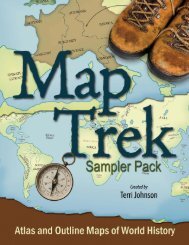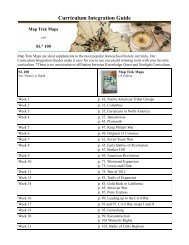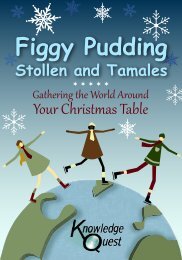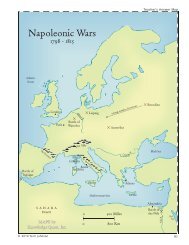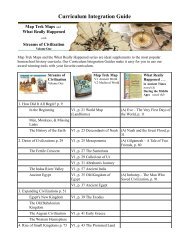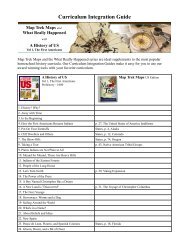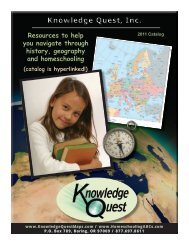Create successful ePaper yourself
Turn your PDF publications into a flip-book with our unique Google optimized e-Paper software.
A Child's Geography: Explore the Holy Landsimilar to that 6:1 proportion! Perhaps the space pictures have merely captured an image of anunusual rock formation—or maybe we are very close to uncovering Noah’s ark after all this time!The children who live today at the base of the looming,volcanic Mount Ararat, in the village of Dogubayazit, tellvisitors that they indeed live in Noah’s countryside. (Canyou imagine saying that?) For down through the ages,fathers and mothers in this region of Turkey havegathered children on their knees to tell them the story ofNoah and the ark with its cargo of antelopes and gorillasand butterflies and flamingos, and all the other marvels ofthe animal kingdom, perched high atop Ararat. This storyof God’s goodness and His love for Noah—and of allhumanity—leaves the Turkish children of today, living inthe shadow of the mountain, to exclaim all good things asbeing the “the luck of Noah!” I think Noah would rathercall such good things the “Grace of God!”Lake Van is Turkey’s largest lake. Fed by sulfursprings, the lake is very salty, making the waterunusable for drinking or farming. Would you besurprised to see a cat swimming here?At home on my childhood farm, we marveled at the grace of God experienced by our barnyard cats.Incredibly, those cats survived all manner of near scrapes and accidents. Our travels now take us toa strange occurrence that is far more incredible than nine-lived farm cats. It is a glorious feat of ourCreator God!South of Turkey’s highest mountain, Mount Ararat, we find Turkey’s largest and deepest lake, thetriangular-shaped Lake Van. It’s not surprising that few cities dot this desolate region of Turkey;yet it is unusual to find so few cities surrounding an all-important water source. That is because LakeVan is one very salty body of water and salty water does little to help thirsty animals or crops in thefields. Since Lake Van is fed by sulfur springs and has no apparent outlet to flow into, it keepsgrowing saltier and saltier! In the chill of winter, you won’t find any ice skaters on Lake Van as youwould at many frozen lakes. Although the winters in this part of Turkey are bitterly cold, the highsalt content keeps the lake from freezing.However, if you squint your eyes, you may catch a glimpse of something that is most startling andincredible here at Lake Van. Look closely and you may see a white and red-haired cat swimmingdown there among the islands. Known as the Swimming Cat, or named a van kedi in Turk, Vancats, as they are called, are one of the rarest breeds of cats in the world. In this region oftemperature extremes, you may never see skaters on a blustery winterday, yet the relentless summer heat may allow one to witness Van catscooling off with a dip in the salty Lake Van water. Yes, a cat that likes toswim!! Our God is a God of surprises! While other cats have threetypes of hair, God especially created the Van cat with only one type ofhair, which feels like soft cashmere or rabbit fur that dries quickly whenwet—which is especially beneficial if you are a swimming cat with anunusual love for water! When the bitter winter descends in this region ofTurkey, the Van cats grow a thick coat to withstand the harsh weather.If a Van cat down there in the lake turns to catch a glimpse of you up onThe beautiful and unusualvan kedi has bi-colored eyes.Photo courtesy of allaboutturkey.comyour carpet, you’ll never forget its gaze—for a Van kedi has one ambereye—and one blue eye! Our incredible Creator God has created a catwith a penchant for swimming—and an astonishing, unforgettable set of16
A Child's Geography: Explore the Holy Landtwo-colored eyes. Such multi-colored creation sets us in mind of the rainbow that God once archedacross this Turkish sky and Noah’s Ark up on Mount Ararat, doesn’t it?The village of Haran, where Abraham and his family once lived, stillhas beehive-shaped mud houses, just as it would have thousands ofyears ago. Photo courtesy of holylandphotos.orgSlipping further south now, deep down intothe Turkish Mesopotamia, we gaze down onthe treeless plateau. A dark haired boy andhis father herd a flock of Angora sheep to amuddy waterhole for a drink outside a smallrural village. A mother wearing a white hairkerchief walks down a dusty dirt street witha baby propped on her hip. This is Haran,one of the oldest continuously inhabitedplaces on Earth—and the home ofAbraham. God’s word reads “Terah took hisson Abram, his grandson, Lot, son of Haran, andhis daughter-in-law, Sarai, the wife of his sonAbram…to Haran [and] they settled there”(Genesis 11:31). Abraham’s address onceread: Abraham: Haran, Turkey.At one time the junction of the Damascus road and the highway between Nineveh and Carchemish,Haran was also the place where Abraham’s father, Terah died, (Genesis 11:32), where God spoke toAbraham about following Him to a promised land, where Rebekah’s brother, Laban once had hishome (Genesis 27:43), and where Jacob fled to escape the fury of his brother, Esau (Gen 27:41-43).In captivating Turkey, children like you live today where Noah first climbed from the ark and walkon the same dirt streets of Haran where Abraham and his descendants once walked with theirflocks!As you look across the landscape from Haran,you will see rolling hills, horse-drawn carts,goats, and sheep, and girls in brightly coloreddresses, their hair covered in scarves. (Somesay there may now be more farm animals thanpeople in Haran!) What you won’t see inHaran are trees. Without trees, you will notfind any houses built of wood. So, how dothe families of Haran build their homes? It isthought that for at least the last 3,000 yearshouses in Haran have been built the sameway: out of the dirt of the Earth. People usewhat God has given them where they live, tobuild their homes and make a living. Withouttrees, people make houses of mud!These beehive houses stay cool in summer and warm in winter.Some houses even have electricity and cable television! Photo courtesyof holylandphotos.orgAs a kid, I made mud pies, mud balls, mud cakes, but never mud houses! The mud houses of Haranare the most memorable houses you may ever see. Not square, not with flat roofs, or with peakedroofs, but like…beehives! For thousands of years the mud houses of Haran have been built likebeehives with conical roofs. These homes seem to be an extension of the land they are settled on,growing right up out of the dirt. Why do the people of Haran build such seemingly strange houses?17
A Child's Geography: Explore the Holy LandAgain, the geography of a place determines how people live: Haran is veryhot in summer and cold in winter—and these beehive-shaped homes staycool in summer and warmer in winter. Do not be fooled by the rusticappearances, however. These mud houses have electricity and some evenhave cable television! If we stepped out of the beating sun of Haran’sstreets and into the cool shade of a bee-hive house, we would find Turkishcarpets hanging on the walls, and laying on the floors. We could sit asTurks traditionally sit, on pillows on the carpet, and share with this family asimple lunch: a hunk of cheese made from sheep’s milk, a few slices ofsalami with pide, a broad, round and flat kind of bread made of wheat,washed down with the traditional Turkish drink, ayran, made of yoghurtand water. (If you were to walk into a McDonald’s in Istanbul, you couldorder ayran alongside your Big Mac! Or you could also order the Turksother favorite drink: a coke!)Care to have an Ayran?In Turkey’s rural areas, ahost’s standard drink forguests is an ayran. "Wehave come to drink yourayran" say the guests.Field NotesWhat a fascinating ride we’ve had so far! Are you imagining life in a beehive house as I am? I’mso excited to hear about what you have seen!Press Record and talk to me…~ about Mount Ararat and the ark: What is thatregion like today? Has the ark been found?Can you locate Mount Ararat on your map?~ about Lake Van: What is unusual about Lake Van? Why don’t more people livearound the lake? Can you ice skate there in the winter? Why not? Tell me about theamazing creature that swims in the lake.~ about Haran’s mud houses: What do they look like? Why do the people buildthem in this way? How does geography affect where people live? Who in real lifeonce lived in or passed through Haran? Describe life in Haran today.After lunch, we swoop further to the West, where we find the bustling city of Tarsus. The Turkishtown of Tarsus was once an important sea port on the brilliantly blue Mediterranean sea butbecause of the silting up, Tarsus is now located some 9.3 miles [15 km] away from the lapping18
A Child's Geography: Explore the Holy Landwaves of the Mediterranean Sea and its sandy beaches. Over time, God’s command of the windsand waters actually shapes and changes the geography of this world!Cleopatra’s Gate named for the Egyptian Queen who visited Tarsusaround 40 B.C. It is believed that Cleopatra disguised herself as theGreek goddess Aphrodite and sailed through the gate to meet MarcAntony, a Roman leader. The city of Tarsus is also the birthplace ofthe Apostle Paul. Photo courtesy of holylandphotos.org19You may have read of the bustling city ofTarsus before? This city of narrow,cobblestone streets rising up out of thecotton fields of the Mediterranean region ofTurkey was the birth place of the ApostlePaul. In Acts 21:39, Paul says, “I am a Jew ofTarsus in Cilicia, a citizen of no insignificant city.”Tarsus was certainly a significant city,hosting such famous historical figures asAlexander the Great, Cleopatra, MarcAntony, Julius Caesar and Cicero! Leaningover the edge of our carpet, we see Tarsussituated on the edge of a fertile plain, cedargroves surrounding its rising buildings. Aplain is an expanse of level, or nearly level,land. (Do you remember what wegeographers call a plain that rises up out ofthe landscape like a table? Yes, a plateau or tableland!) In general, plains may be more suitable forfarming than elevated plateaus like the Anatolia or steep mountains, such as the rugged TaurusMountains running like a fence between these narrow Mediterranean coastal plains and the Anatolia.Orange and lemon trees, lush banana trees, and waving fields of wheat and barley grow up out ofthe rich soil. Rice and cotton are also bountiful where precious water is irrigated upon the land. Inthe fields where the Apostle Paul once walked, we may now see combines harvesting soft whiteballs of cotton to make textiles, fabric and clothing, one of Turkey’s most important industries.(One of my favorite pair of cotton pants has a tag reading: Made in Turkey. I’m amazed to thinkthat those pants first began as a cotton plant growing up out of this Turkish dirt!)As we fly over the Mediterranean coast, white sails wave at us from boats bobbing on the brilliantblue water, and numerous productive farming villages quietly dot the coastline. Dropping closer,strange, bizarre shapes rising up out of the landscape catch our eye…stranger than mud houses,stranger than beehive-shaped houses. We’ve stumbled into the land of the Fairy Chimneys in theCappadocia region of the Anatolian Plateau. (Look for Lake Tuz, and the area between Konya andKayseri on your map of Turkey.)No bees lived in the beehive houses of Haran, and neither do any fairies live in the Fairy Chimneysof Cappadocia, but if you imagined there were such things as fairies, would they have houses withchimneys like these strange rock formations? Only our imaginative Creator God could havedreamed up anything as fantastic as these cone-shaped rocks in the Cappadocia!If you’ve ever worn a cap outside to protect yourself from the sun’s beating rays and peltingraindrops, you’ll understand a bit of the structure of these unique formations.God created these strange Fairy Chimneys from the deposits spewed forth from volcanoes on theAnatolian Plateau: first a thick layer of ash fell, then a dust that compressed into a stone called tuffand, lastly, a thin layer of lava that hardened into a sturdy basalt stone. Over time, God has allowedthe outer layer of basalt to crack, and His winds and waters have weathered and washed away the
A Child's Geography: Explore the Holy Landstone into strange shapes. Finally, He sculpts a fairy chimney when a small cap of the original basaltsits atop a cone of tuff. Like when you don a cap, God leaves a cap atop the cone to protect it fromeroding or weathering away. When He eventually sends winds that undercut the cap, the cap fallsoff the fairy chimney, and the chimney itself soon weathers away into nothing….which, thankfully,does not happen to you when you take off your cap!Cappadocia’s “fairy chimneys” are a popular tourist destination. Made ofbasalt, these conical structures are shaped by wind and water through aprocess called erosion.Ironically, the Fairy Chimneys are in aregion of Turkey called Cappadocia—aname which actually has nothing to dowith caps but means “the land ofbeautiful horses.” Let’s slide off ourfloating kilim and ride a sleekthoroughbred horse up through whatsome consider Turkey’s mostspectacular scenery. If you feel afraidin dark, small places, you may want tostay with our beautiful horse instead ofexploring into the shadows of the FairyChimneys.When I was young, my brother, sisterand I would head up to the haymowin the barn to make mazes of tunnelsand secret rooms dark and deepwithin the mountain of bales. Riding our horse up through Cappodicia, we would hardly imaginethat underneath these mountains and towers of Fairy Chimneys lay tunnels eight levels deep withwhole cities of underground rooms!The Hittites of the Old Testament were the first people to carve into the soft rock of the FairyChimneys to create granaries for their grain stores. Geography, how God forms the land, benefitspeople down through the ages; the constant cool of the dark caves was the perfect temperature topreserve grains. But no one dug out actual houses in which to live inthis brittle, tawny-colored tuff until after the time of Jesus, whenpersecuted Christians sought hiding places from the Roman Empire.In the three hundred years after Jesus, tens of thousands of newChristians carved bedrooms and stables and churches and flourmillsinto the Fairy Chimneys—and deep down away into massiveunderground cities. Perhaps as many as 60,000 New TestamentChristians lived in the mazes and labyrinths of low twisting passagesleading to room upon room: a whole community of people, livingdeep underground! The Fairy Chimneys became the Christian’schimneys. God had created the geography of the land to provideperfect homes for these new believers. In the hot Turkey summers,these caves and tunnels were a cool relief, and in bitter winters, theFairy Chimneys and underground cities of Cappodocia providedprotection from the winds and cold.20
A Child's Geography: Explore the Holy LandIf you’d like to experience what those early Christians felt living in the underground Cappodociancities, there are Fairy Chimney hotels that will let you even sleep here in an underground room ofyour own! What do you think that would be like?The Fairy Chimneys with their “caps.” In this same region are amazingunderground cities, originally developed by the ancient Hittites.Before we check in for the night, let’s saila bit further north into the CentralAnatolian Plateau to Tuz Golu, where youwill see a sight that simply must not bemissed. As the sun is setting pink in thesky, do you notice the lake below,gleaming with its own hues of white andpink? If you could speak Turkish, you’dknow that Tuz means “salt” and Golumeans “lake.” Tuz Golu is Turkey’ssecond largest lake, after Lake Van, but itis one of the largest salt lakes in the world!Lake Tuz is fed by salt springs and, withno drainage outlet, the salt content keepsincreasing as water evaporates, leaving thesalt behind. While saltier than Lake Van,it is much shallower, with a depth of only 3-6 feet [1-2 m]. In the summer, the sun’s heat evaporatesmuch of the water making it possible to walk across the whole lake, hardly getting your legs wet!Don’t forget your shoes though; otherwise you’ll spend your day shrieking “Ow! Ow! Ouch!” asthose sharp, hard salt crystals poke at the bottom of your feet. Because it is not very deep, the saltcrystals caked to the bottom of the lakebed gleam a brilliant white, making Tuz Golu look like ahuge salt pan—with a pink haze hanging over it. The haze comes from particular pink algae thatgrow in this water, the only life that can live under such salty conditions. People however, do livenear Lake Tuz, working in mines to process most of the salt that is used in Turkey. God’simaginative geography not only createsbeauty—like that glorious pink hue of TuzGolu mirroring the brilliance of the sunset—but also provides families and peoples with theresources necessary for living—from the timeof Noah, to today.From the dizzying heights of Mount Ararat, tothe dark depths of underground cities andhouses carved into the rock of Fairy Chimneys,Turkey is the home of new beginnings.Stepping out on Mount Ararat, Noah and hisfamily begin a new life in the new world afterthe Global Flood. From his mud, beehiveshapedhouse in Haran, Old TestamentAbraham made a new start in his quest afterGod. Setting out from his coastal village ofTarsus, New Testament Apostle Paul brought anew religion of hope to ears that had neverheard. And deep within the Fairy Chimneys ofCappadocia, early Christians hid from oldDoesn’t our view from a spacecraft window clearly show howLake Tuz is like a salt pan? Two major rivers, groundwater, andsurface water feed Lake Tuz, but the lake has no drainage outlet.The lake becomes very salty during the summer with most ofwater in the lake drying up, leaving an average of a foot [30 cm]thick salt layer! Three mines near the lake process and refinethe salt for people to use. Photo courtesy of visibleearth.nasa.gov21
A Child's Geography: Explore the Holy Landpowers and ways to grow a strong faith in a world after Jesus. With such fascinating stories, whowouldn’t pull down their heart-shaped, Made-in-Turkey plate, and feel a genuine love for thecountry of Turkey—and He who created it all, our Glorious God?!Field NotesWeren’t those Fairy Chimneys amazing? I’m not sure I’d want to sleep underground though.Would you? I’m ready to hear all about your trip!Press record and talk to me…~ about Tarsus and the Mediterranean coastalplains: What is a plain? What crops grow in thisregion? Which Apostle was born in Tarsus? Canyou name any other famous people who visited there? Howhas God changed the geography of Tarsus over time?~ about the Fairy Chimneys: Describe one to me. How does God form a FairyChimney? Can you name the region in which they are found? Tell me about theunderground cities. Who lived there? Why?~ about Toz Golu: What color is it? Why? What other unusual characteristics doesthe lake have? Why do people live near Toz Golu? Tell me about salt. Take me on animaginary walk across the lake.22
A Child's Geography: Explore the Holy LandTravel LogUsing your globe or atlas, let’s add the following locations to your map ofTurkey. We’ve seen things today that simply must be mapped, so that they willnever be forgotten!Don’t worry about making a perfect map, just do your best. Drawing the basicshape yourself will help you remember it better. Or you can use the mapprovided for you on the CD-ROM.Map Notes: Let’s record the locations of:• Mt. Ararat• Lake Van• Haran• Tarsus• Cappadocia• Tuz GoluIf you’d like, draw pictures or symbols on your map representing:The Ark (perched right on top of Mt. Ararat)Van kedis or Van cats (swimming in Lake Van!)Beehive housesFairy chimneysCrops growing on the coastal plains (there are a lot to choose from, justpick a couple of your favorites)Underground citiesSalt shaker (on the shallow Lake Tuz)(Challenge Mapping: Can you point out the following regions on your map: BlackSea Region, Central Anatolian Region, And Mediterranean Region)Travel Notes: Geographers write what they’ve seen in order to share theadventure with others—and so they can revisit the places in their memories!On the next page of your travel log, record three important sights youwant to remember from your tales of Turkey.23
A Child's Geography: Explore the Holy Land~art ~books ~food ~music ~poetryBringing It HomeSimple ideas to bring the world to your doorBooksThe Hungry Coat by DemiIn this Turkish folk tale, Nasrettin Hoca (a medieval philosopher and folk hero) finds his friendstreat him differently when he is wearing an old coat and decides to teach them a funny lesson.*all agesThe Tigris and Euphrates Rivers by Melissa WhitcraftFollow the Tigris and Euphrates through the Middle East, learning history and geography along theway. **Read aloud or older readersTurkey by Tamra OrrTake an indepth look at Turkey’s history, peoples and places. **Read aloud or older readersPoetryThe aim in learning isTo understand God's Truth.Because without knowledgeIt is wasted hard labour. ~Yunus Emre (1238-1320)(Yunus Emre was a thirteenth century whirling dervish from Anatolia.)24





